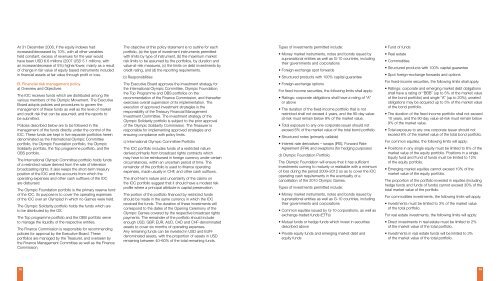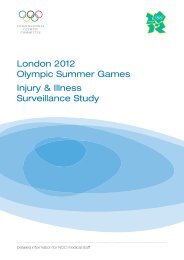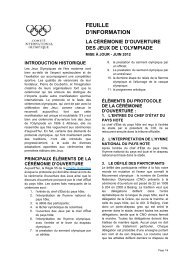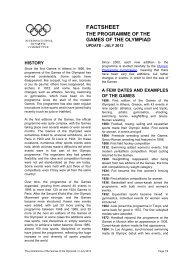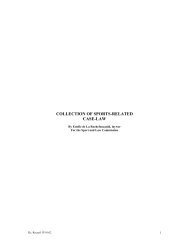3912 reportcomplete final web:layout 1
3912 reportcomplete final web:layout 1
3912 reportcomplete final web:layout 1
You also want an ePaper? Increase the reach of your titles
YUMPU automatically turns print PDFs into web optimized ePapers that Google loves.
At 31 December 2008, if the equity indexes had<br />
increased/decreased by 10%, with all other variables<br />
held constant, excess of revenues for the year would<br />
have been USD 6.6 millions (2007 USD 5.1 millions, with<br />
an increase/decrease of 5%) higher/lower, mainly as a result<br />
of change in fair value of equity based instruments included<br />
in financial assets at fair value through profit or loss.<br />
B. Financial risk management policy<br />
a) Overview and Objectives<br />
The IOC receives funds which are distributed among the<br />
various members of the Olympic Movement. The Executive<br />
Board adopts policies and procedures to govern the<br />
management of these funds as well as the level of market<br />
and credit risk that can be assumed, and the reports to<br />
be submitted.<br />
Policies described below are to be followed in the<br />
management of the funds directly under the control of the<br />
IOC. These funds are kept in five separate portfolios herein<br />
denominated as the International Olympic Committee<br />
portfolio, the Olympic Foundation portfolio, the Olympic<br />
Solidarity portfolio, the Top programme portfolio, and the<br />
OBS portfolio.<br />
The International Olympic Committee portfolio holds funds<br />
of a restricted nature derived from the sale of television<br />
broadcasting rights. It also keeps the short-term treasury<br />
position of the IOC and the accounts from which the<br />
operating expenses and other cash outflows of the IOC<br />
are disbursed.<br />
The Olympic Foundation portfolio is the primary reserve fund<br />
of the IOC. Its purpose is to cover the operating expenses<br />
of the IOC over an Olympiad in which no Games were held.<br />
The Olympic Solidarity portfolio holds the funds which are<br />
to be distributed by the OS.<br />
The Top programme portfolio and the OBS portfolio serve<br />
to manage the liquidity of the respective entities.<br />
The Finance Commission is responsible for recommending<br />
policies for approval by the Executive Board. These<br />
portfolios are managed by the Treasurer, and overseen by<br />
the Finance Management Committee as well as the Finance<br />
Commission.<br />
78<br />
The objective of this policy statement is to outline for each<br />
portfolio, (a) the type of investment instruments permitted<br />
with limits by type of instrument, (b) the maximum market<br />
risk limits to be assumed by the portfolios, by duration and<br />
value-at-risk measures, (c) the limits on debt investments by<br />
credit rating, and (d) the reporting requirements.<br />
b) Responsibilities<br />
The Executive Board approves the investment strategy for<br />
the International Olympic Committee, Olympic Foundation,<br />
the Top Programme and OBS portfolios on the<br />
recommendation of the Finance Commission, and thereafter<br />
exercises overall supervision of its implementation. The<br />
execution of approved investment strategies is the<br />
responsibility of the Treasury Financial Management<br />
Investment Committee. The investment strategy of the<br />
Olympic Solidarity portfolio is subject to the prior approval<br />
of the Olympic Solidarity Commission. The Treasurer is<br />
responsible for implementing approved strategies and<br />
ensuring compliance with policy limits.<br />
c) International Olympic Committee Portfolio<br />
The IOC portfolio includes funds of a restricted nature<br />
derived primarily from broadcast rights contracts which<br />
may have to be reimbursed in foreign currency under certain<br />
circumstances, within an uncertain period of time. The<br />
remainder of the portfolio is used to finance operating<br />
expenses, made usually in CHF, and other cash outflows.<br />
The short-term nature and uncertainty of the claims on<br />
the IOC portfolio suggest that it should have a modest risk<br />
profile where a principal attribute is capital preservation.<br />
The portion of the portfolio financed by restricted funds<br />
should be made in the same currency in which the IOC<br />
received the funds. The duration of these investments will<br />
correspond to the dates of the Opening Ceremony of the<br />
Olympic Games covered by the respective broadcast rights<br />
payments. The remainder of the portfolio should include<br />
enough USD, GBP, EUR, AUD, CAD and CHF-denominated<br />
assets to cover six months of operating expenses.<br />
Any remaining funds can be invested in USD and EURdenominated<br />
assets, with the proportion of assets in USD<br />
remaining between 40–60% of the total remaining funds.<br />
Types of investments permitted include:<br />
Money market instruments, notes and bonds issued by<br />
supranational entities as well as G-10 countries, including<br />
their governments and corporations<br />
Foreign-exchange spot forwards<br />
Structured products with 100% capital guarantee<br />
Foreign-exchange options<br />
For fixed-income securities, the following limits shall apply:<br />
Ratings: corporate obligations shall have a rating of “A”<br />
or above<br />
The duration of the fixed-income portfolio that is not<br />
restricted shall not exceed 4 years, and the 90-day valueat-risk<br />
must remain below 9% of the market value.<br />
Total exposure to any one corporate issuer should not<br />
exceed 6% of the market value of the total bond portfolio.<br />
Structured notes (primarily callable)<br />
Interest rate derivatives – swaps (IRS), Forward Rate<br />
Agreement (FRA) and swaptions (for hedging purposes)<br />
d) Olympic Foundation Portfolio<br />
The Olympic Foundation will ensure that it has sufficient<br />
investments coming to maturity or realisable with a minimum<br />
of loss during the period 2009–2012 so as to cover the IOC<br />
operating cash requirements in the eventuality of a<br />
cancellation of the 2010 Olympic Games.<br />
Types of investments permitted include:<br />
Money market instruments, notes and bonds issued by<br />
supranational entities as well as G-10 countries, including<br />
their governments and corporations<br />
Common equities issued by G-10 corporations, as well as<br />
exchange-traded funds (ETFs)<br />
Mutual funds or hedge funds which invest in securities<br />
described above<br />
Private equity funds and emerging market debt and<br />
equity funds<br />
Fund of funds<br />
Real estate<br />
Commodities<br />
Structured products with 100% capital guarantee<br />
Spot foreign-exchange forwards and options<br />
For fixed-income securities, the following limits shall apply:<br />
Ratings: corporate and emerging market debt obligations<br />
shall have a rating of “BBB” (up to 5% of the market value<br />
of the bond portfolio) and single “A” (up to 20%); unrated<br />
obligations may be acquired up to 5% of the market value<br />
of the bond portfolio.<br />
The duration of the fixed-income portfolio shall not exceed<br />
10 years, and the 90-day value-at-risk must remain below<br />
9% of the market value.<br />
Total exposure to any one corporate issuer should not<br />
exceed 6% of the market value of the total bond portfolio.<br />
For common equities, the following limits will apply:<br />
Positions in any single equity must be limited to 6% of the<br />
market value of the equity portfolio. Positions in a single<br />
Equity fund and Fund of funds must be limited to 12%<br />
of the equity portfolio.<br />
Emerging market equities cannot exceed 10% of the<br />
market value of the equity portfolio.<br />
The proportion of the portfolio invested in equities (including<br />
hedge funds and funds of funds) cannot exceed 30% of the<br />
total market value of the portfolio.<br />
For commodities investments, the following limits will apply:<br />
Investments must be limited to 3% of the market value<br />
of the total portfolio.<br />
For real estate investments, the following limits will apply:<br />
Direct investments in real estate must be limited to 2%<br />
of the market value of the total portfolio.<br />
Investments in real estate funds will be limited to 3%<br />
of the market value of the total portfolio.<br />
79


